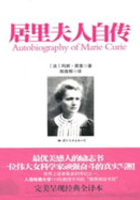
第12章 婚后生活 (5)
I had occasion to examine a certain number of minerals. A few of them showed activity; they were those containing either uranium or thorium. The activity of these minerals would have had nothing astonishing about it, if it had been in proportion to the quantities of uranium or thorium contained in them. But it was not so. Some of these minerals revealed an activity three or four times greater than that of uranium. I verified this surprising fact carefully, and could not doubt its truth. Speculating about the reason for this, there seemed to be but one explanation. There must be, I thought, some unknown substance, very active, in these minerals. My husband agreed with me and I urged that we search at once for this hypothetical substance, thinking that, with joined efforts, a result would be quickly obtained. Neither of us could foresee that in beginning this work we were to enter the path of a new science which we should follow for all our future.
Of course, I did not expect, even at the beginning, to find a new element in any large quantity, as the minerals had already been analyzed with some precision. At least, I thought there might be as much as one per cent of the unknown substance in the minerals. But the more we worked, the clearer we realized that the new radioactive element could exist only in quite minute proportion and that, in consequence, its activity must be very great. Would we have insisted, despite the scarcity of our means of research, if we had known the true proportion of what we were searching for, no one can tell; all that can be said now is that the constant progress of our work held us absorbed in a passionate research, while the difficulties were ever increasing. As a matter of fact, it was only after several years of most arduous labor that we finally succeeded in completely separating the new substance, now known to everybody as radium. Here is, briefly, the story of the search and discovery.
As we did not know, at the beginning, any of the chemical properties of the unknown substance, but only that it emits rays, it was by these rays that we had to search. We first undertook the analysis of a pitchblende from St. Joachimsthal. Analyzing this ore by the usual chemical methods, we added an examination of its different parts for radioactivity, by the use of our delicate electrical apparatus. This was the foundation of a new method of chemical analysis which, following our work, has been extended, with the result that a large number of radioactive elements have been discovered.
In a few weeks we could be convinced that our prevision had been right, for the activity was concentrating in a regular way. And, in a few months, we could separate from the pitchblende a substance accompanying the bismuth, much more active than uranium, and having well defined chemical properties. In July, , we announced the existence of this new substance, to which I gave the name of polonium, in memory of my native country.
While engaged in this work on polonium, we had also discovered that, accompanying the barium separated from the pitchblende, there was another new element. After several months more of close work we were able to separate this second new substance, which was afterwards shown to be much more important than polonium. In December, , we could announce the discovery of this new and now famous element, to which we gave the name of radium.
However, the greatest part of the material work had yet to be done. We had, to be sure, discovered the existence of the remarkable new elements, but it was chiefly by their radiant properties that these new substances were distinguished from the bismuth and barium with which they were mixed in minute quantities. We had still to separate them as pure elements. On this work we now started.
We were very poorly equipped with facilities for this purpose. It was necessary to subject large quantities of ore to careful chemical treatment. We had no money, no suitable laboratory, no personal help for our great and difficult undertaking. It was like creating something out of nothing, and if my earlier studying years had once been called by my brother-in-law the heroic period of my life, I can say without exaggeration that the period on which my husband and I now entered was truly the heroic one of our common life.
We knew by our experiments that in the treatment of pitchblende at the uranium plant of St. Joachimsthal, radium must have been left in the residues, and, with the permission of the Austrian government, which owned the plant, we succeeded in securing a certain quantity of these residues, then quite valueless, and used them for extraction of radium. How glad I was when the sacks arrived, with the brown dust mixed with pine needles, and when the activity proved even greater than that of the primitive ore! It was a stroke of luck that the residues had not been thrown far away or disposed of in some way, but left in a heap in the pine wood near the plant. Some time later, the Austrian government, on the proposition of the Academy of Science of Vienna, let us have several tons of similar residues at a low price. With this material was prepared all the radium I had in my laboratory up to the date when I received the precious gift from the American women.